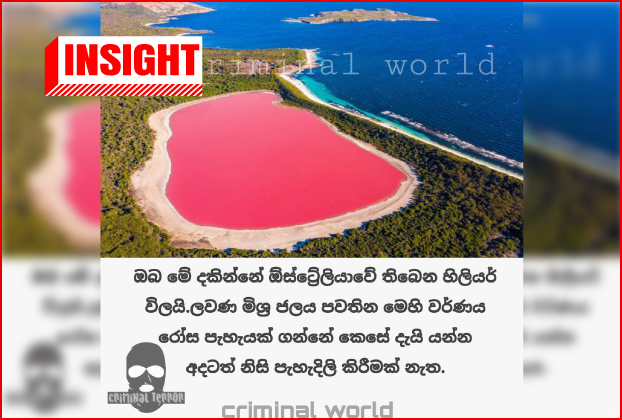People are often intrigued by mysterious phenomena, drawn to the enigmatic and unexplained. However, there are instances where events with clear scientific explanations are misconstrued and circulated on social media as mysterious occurrences, perpetuating misunderstanding and misinformation.
Social Media Posts
Social media posts in Sri Lanka claim the vibrant pink colour of Lake Hillier in Australia remains a scientific enigma.

We decided to do a fact-check on this.
Explanation
Imagine a lake with water the colour of a strawberry milkshake. That’s Lake Hillier, a natural lake located on Middle Island off the coast of Western Australia. This saline lake stretches about 600 meters and is known for its vibrant pink hue that remains even when scooped into a cup. Surrounded by dunes and eucalyptus trees and separated from the ocean by a thin beach, Lake Hillier offers a stunning contrast of colours and a genuinely otherworldly landscape.
As per some reports, the culprit behind Lake Hillier’s mesmerising pink hue lies in a microscopic world – a combination of halophilic algae and bacteria thriving in the lake’s extremely salty environment. Here’s a breakdown of the key players:
Dunaliella salina: This superstar algae species thrives in high salinity. When exposed to intense sunlight, Dunaliella salina produces beta-carotene, a reddish pigment similar to what gives carrots their orange colour. This pigment acts like a natural sunscreen, protecting the algae from harmful UV rays.
Halobacteria (Halobacterium salinarum): These salt-loving bacteria also contribute to the pink spectacle. They contain a pigment called bacterioruberin, which appears pink and helps them absorb sunlight for energy production.
More details about it can be read here Archived.
More details about such prominent research done recently in 2022 were also mentioned on the famous Newscientist website.
As per the new scientist web, this research can be considered insightful research that sheds light on the decades-long mystery.
Scott Tighe, one of the co-founders of the Extreme Microbiome Project (XMP), collaborates globally to profile extreme environments, aiming to uncover novel genetic microbes. Partnering with Ken McGrath from Microba, a microbial genomics firm in Brisbane, Australia, they conducted fieldwork at Lake Hillier, collecting water and sediment samples.
Utilising metagenomics, a technique that involves sequencing all DNA in a sample simultaneously, Tighe, McGrath, and their team analysed the samples. Subsequently, robust computational tools identified individual microbial genomes.
Their examination unveiled nearly 500 Lake Hillier extremophiles comprising bacteria, archaea, algae, and viruses. These extremophiles are predominantly halophiles adept at thriving in high-salt environments.
Among these halophiles were vibrant microbial species such as purple sulphur bacteria, red orange Salinibacter ruber, and red Dunaliella salina algae. Tighe suggests combining these microbes, among possibly others, contributes to the lake’s distinctive pink hue.
Tighe proposes that these microbes’ colourful pigments, carotenoids, may offer protection against extreme salinity.
While some of the microbes identified in Lake Hillier may be novel to science, Tighe notes that further characterisation is required. The report of the Newscientist web can be reached here. The related academic research paper can be read here.
While the exact ratios of these organisms and their precise contributions to the pink colour may require further investigation, the scientific community has a well-understood explanation for Lake Hillier’s captivating pink hue. It’s a testament to the remarkable adaptations of life forms in extreme environments.
Follow us and stay up to date with our latest fact checks.
Facebook | Twitter | Instagram | Google News | TikTok

Title:Fact Check: Unveiling the Pink Mystery of Lake Hillier
Fact Check By: Kalana KrishanthaResult: Insight






